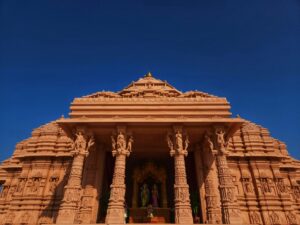
India, the birthplace of multiple religions and home to thousands of sacred sites, is one of the world’s most significant destinations for spiritual travel. With its deep-rooted traditions, centuries-old temples, mosques, churches, gurudwaras, and monasteries, India offers a profound spiritual experience to seekers, pilgrims, and tourists alike. From the mighty Himalayas to the southern shores of Tamil Nadu, Religious Tourism in India connects people to divine destinations, cultural heritage, and timeless rituals.
What is Religious Tourism?
Religious tourism involves traveling to sacred places for the purpose of spiritual growth, worship, or to experience religious history and culture. In India, it goes far beyond temple visits—it’s a journey of emotions, faith, rituals, and community, often woven with vibrant festivals, holy rivers, and powerful legends.
Importance of Religious Tourism in India
- Cultural Preservation: Religious sites are living museums of India’s spiritual and artistic history.
- Spiritual Enrichment: Travelers often find inner peace, purpose, and mindfulness through rituals and meditation.
- Economic Impact: Pilgrimage tourism supports local economies, especially in remote regions.
- Social Unity: Religious tourism fosters communal harmony by encouraging understanding of different faiths.
Top Destinations for Religious Tourism in India
1. Varanasi (Uttar Pradesh)
Considered the spiritual capital of India, Varanasi is sacred to Hindus. The Ganga Aarti at Dashashwamedh Ghat and visits to Kashi Vishwanath Temple offer deeply moving experiences.
2. Rameswaram (Tamil Nadu)
One of the Char Dham pilgrimage sites, Rameswaram is associated with Lord Rama. Its Dravidian-style temples and sea rituals attract thousands of devotees.
3. Amritsar (Punjab)
Home to the Golden Temple (Harmandir Sahib), the most important pilgrimage site for Sikhs. The temple’s stunning architecture and the langar (free community meal) embody unity and service.
4. Bodh Gaya (Bihar)
The place where Gautama Buddha attained enlightenment under the Bodhi Tree. It’s a major center for Buddhist tourism worldwide.
5. Tirupati (Andhra Pradesh)
The Venkateswara Temple in Tirumala is one of the richest and most visited temples in the world, drawing millions of devotees annually.
6. Ajmer Sharif (Rajasthan)
This Dargah of Sufi saint Moinuddin Chishti attracts followers of all religions who come to seek blessings and peace.
7. Vaishno Devi (Jammu & Kashmir)
A revered Hindu pilgrimage site located in the Trikuta Mountains, accessible via a trek, ropeway, or helicopter ride.
8. Shirdi (Maharashtra)
Devotees of Sai Baba flock to Shirdi throughout the year for spiritual healing and faith-driven experiences.
9. Dwarka and Somnath (Gujarat)
Ancient temples of Lord Krishna and Shiva form a major part of the Char Dham and Jyotirlinga circuits.
10. Kedarnath & Badrinath (Uttarakhand)
Part of the Char Dham Yatra, these high-altitude temples offer stunning Himalayan backdrops and a deeply spiritual atmosphere.
Types of Religious Tourism in India
- Pilgrimage Tours: Devotees travel to sacred temples, mosques, churches, and monasteries during special festivals or religious seasons.
- Spiritual Retreats: Yoga, meditation, and wellness retreats in places like Rishikesh and Auroville attract global travelers.
- Festival-Based Tourism: Participating in grand religious festivals such as Kumbh Mela, Diwali in Varanasi, or Eid in Delhi.
- Heritage & Cultural Tours: Visiting architectural marvels and historical religious monuments that showcase India’s pluralistic past.
Popular Religious Circuits
- Char Dham Yatra: Yamunotri, Gangotri, Kedarnath, and Badrinath in Uttarakhand.
- Jyotirlinga Circuit: 12 sacred Shiva shrines across India.
- Pancha Bhoota Sthalam: Five temples dedicated to Shiva representing the five elements.
- Buddhist Circuit: Lumbini, Bodh Gaya, Sarnath, and Kushinagar.
- Sikh Circuit: Amritsar, Anandpur Sahib, Patna Sahib, Nanded.
Best Time for Religious Tourism in India
- October to March: Most comfortable weather for temple visits and outdoor pilgrimages.
- Festival Seasons: Travel during festivals like Navratri, Diwali, Eid, or Guru Nanak Jayanti adds a colorful, vibrant dimension.
- Monsoon Season (June-August): Ideal for hill shrine visits like Vaishno Devi, but weather conditions should be monitored closely.
Tips for Religious Travelers
- Dress Modestly: Many religious sites require conservative clothing and the removal of shoes.
- Follow Local Customs: Respect rituals, traditions, and photography rules.
- Stay Hydrated and Carry Essentials: Especially important when visiting high-altitude or remote locations.
- Book in Advance: Especially for accommodation during peak pilgrimage seasons.
Conclusion
Religious Tourism in India is a profound blend of faith, history, culture, and self-discovery. Whether you seek divine blessings, spiritual insight, or cultural exploration, India offers a unique experience at every holy corner. From sacred rivers and ancient temples to vibrant festivals and spiritual retreats, each journey leaves behind lasting peace and a deeper understanding of India’s spiritual soul. So, pack your bags with faith and curiosity—your spiritual adventure through the land of gods awaits.








